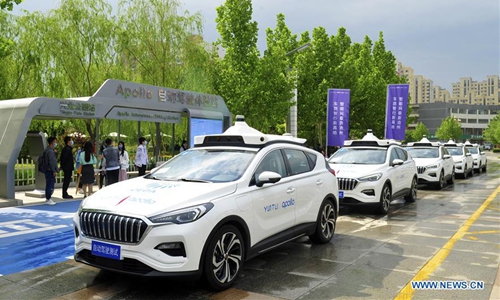SOURCE / INDUSTRIES
Self-driving startup AutoX launches public test rides in its self-driving vehicles

A fleet of self-driving cars are seen at Cangzhou economic development zone in Cangzhou City, north China's Hebei Province, May 14, 2020. The road test area for intelligent connected vehicles (ICVs) was extended from Cangzhou economic development zone to main urban areas of the city on Thursday. (Xinhua/Mu Yu)
China's self-driving car startup AutoX said it plans to build a fleet of thousands of self-driving taxis in two years, following its launch of public test rides in Shanghai. China's autonomous driving industry is growing fast, despite the challenges posed by the coronavirus pandemic.
Although the Chinese autonomous driving sector developed later than in the US, it enjoyed a late-mover advantage compared with the US, which could allow the country to take the lead, industry insiders told the Global Times.
AutoX launched its RoboTaxi self-driving taxi hailing service with only one safety driver in the public testing roads in Jiading district, Shanghai on Monday.
The autonomous vehicles can be hailed through the Alibaba AutoNavi smartphone app and found at a designated pick-up point. Upon entering, users only need to say the last four digits of their cellphone numbers to activate the system and start their journey.
During the trip, passengers can monitor the route through an internal screen, where objects and surroundings around the RoboTaxi vehicle are also displayed so that they can understand how an autonomous vehicle perceives the world and makes decisions.
The company claimed that the self-driving system can realize all the operations required by human drivers in urban driving, including changing lanes, overtaking, handling congestion and making U-turns, just like human drivers.
However, there are certain conditions, a blizzard for example, that unmanned vehicles cannot yet handle, the person in charge of the company told the Global Times Tuesday.
"Therefore, we believe that human drivers and autonomous cars will coexist and complement each other in the future during peak periods," the person said.
AutoX is one of a number of Chinese autonomous driving companies that have taken further steps this year after getting new funding, despite challenges posed by the pandemic.
Didi Chuxing, China's largest ride-hailing platform, launched its self-driving taxi hailing program in Shanghai at the end of June after the company announced it had raised $500 million from investors. The company said it plans to operate more than 1 million autonomous vehicles on its platform by 2030.
In May, Pony.ai obtained a license in Beijing to carry out manned autonomous driving tests, including those for online car hailing and shuttle services. Since April, residents of Changsha in Central China's Hunan Province have been able to hail autonomous taxis for free through Baidu's navigation app Baidu Maps.
Chinese self-driving companies, though being a latecomer in the industry compared with their US peers, enjoy an obvious advantage in labor costs and a more mature industry chain, which allows them to work at a rapid pace to catch up, the person in charge of AutoX said.
"A US company may have to pay 15 times more in labor costs to operate 100 robotaxis at the same level and scale as ours," she said.
"In the past, it would cost $100,000 to buy a LiDAR and it was not available all the time. The cost was largely reduced by the time Chinese startups entered the industry between 2016 and 2017 thanks to the development of domestic LiDARs."
China's comprehensive traffic data and government support at various levels also allows the industry to progress quickly, she added.

